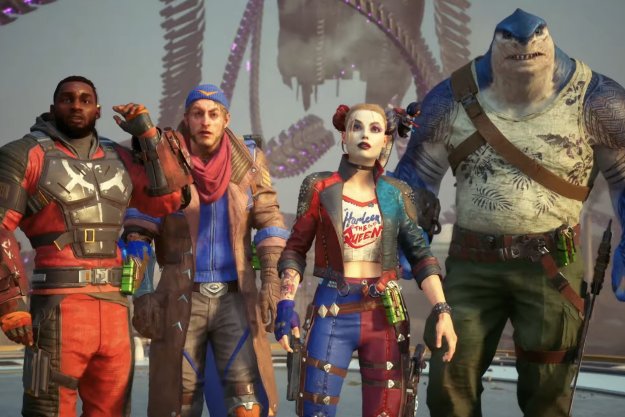
“Suicide Squad: Kill the Justice League constantly finds ways to stop players from enjoying this bombastic cooperative shooter.”
- Rewarding combat and traversal
- Bold storytelling choices
- Solid endgame
- Repetitive mission design
- Lack of cooperative interplay
- Lame microtransactions
- Terrible UI and UX
It took 20 hours of playing Suicide Squad: Kill the Justice League for me to finally start having fun.
That was thanks to Killing Time, a mission type that was unlocked 10 levels into the shooter’s endgame, which is dubbed Finite Crisis. It’s a straightforward survival mode: I had to kill as many enemies as possible within a time limit, gaining time for each enemy killed, while also seeing the difficulty increase. I played with a friend and we both enjoyed taking full advantage of Suicide Squad’s acrobatic third-person shooter combat as we found ways to complement each other’s abilities with late-game skills and affliction usage.
When our time ran out, I was pulled right back to reality. I was plopped back into slow, convoluted menus where I obtained disappointing loot pulls. Suicide Squad is full of contradictory moments like that. For every bold design decision, there’s a caveat that makes the experience much more frustrating than it needs to be.
The best parts of Suicide Squad are its traversal and combat, but the user experience of navigating fights and the Metropolis open world is a mess. Its storytelling is daring, but it botches basics like character introductions. It has a thorough progression system, but lacks the variety in mission design to make that grind entertaining. There is enjoyment to be had in Suicide Squad, alone and with friends, but you’ll have to sift through a lot of dirt for that gold.
The Brave and the Bold
This section contains story spoilers for Suicide Squad: Kill the Justice League.
If nothing else, Suicide Squad lives up to its namesake. Brainiac has taken over the minds of most of the Justice League, and it’s up to the Suicide Squad to stop them after being recruited and thrown into Metropolis by the intimidating Amanda Waller and the secret government organization A.R.G.U.S. It’s set in the Arkhamverse we know and love, but isn’t afraid to kill characters like Batman off, imply that characters like Oracle also died, and fully embrace world-ending, multiversal stakes of Brianiac’s invasion.
It’s an audacious story that’s been off-putting to some, but I commend Rocksteady for taking these bold swings. The Arkham games’ stories stood out because they were willing to do risky things, like killing off the Joker. Rocksteady Games hasn’t lost its narrative edge in that way. I was engaged the whole way through the Suicide Squad campaign as I wondered what would happen next.
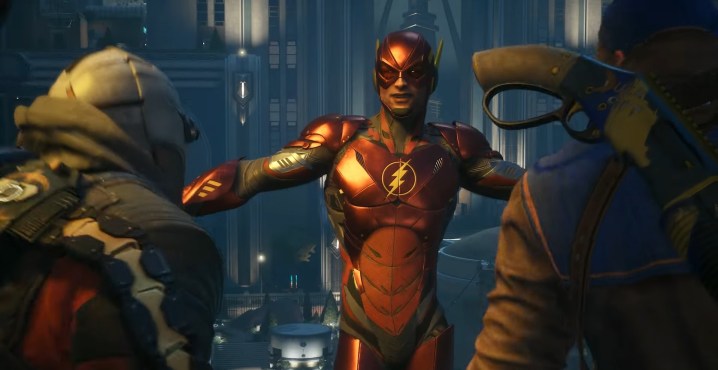
There are plenty of memorable moments, like when King Shark temporarily dons a Green Lantern ring or when Superman kills Wonder Woman. It’s a story that’s also backed up by lots of great performances. The late Kevin Conroy gets to play Batman against type because he’s now evil, and he delightfully eats up every line he’s given in his final performance as the Caped Crusader. Tara Strong is comfortable as Harley Quinn, and Jason Isaacs is devilishly cocky as Brainiac. I’m reminded of the stories and performances that put the Arkhamverse on the map in these moments.
My frustrations with Suicide Squad’s story don’t lie with the twists or performances. Rather, I’m put off by how much it messes up the basics. It never makes a strong case for why this needs to be a multiverse story or why it doesn’t introduce Superman and Brainiac earlier. At its core, this game is about the failures of authority and how those being held down need to band together and support each other. That theme works decently for a Suicide Squad plot, but Brianiac being connected to a multiverse doesn’t do much to reinforce that. It’s a narrative conceit made so that Rocksteady can technically have a near-infinite amount of content to pull from post-launch.
This is not an “evil Superman” story done right.
Suicide Squad expects players to know a lot about these comic book characters before they begin. Although players are almost immediately thrown into a Metropolis under siege, the introduction of Superman and Brainiac are held back for so long that the stakes of the threat never set in that effectively. When Superman shows up, Rocksteady assumes you know the character well enough to care that he’s gone completely evil.
Before you know it, Batman and Superman are dead, and Brainiac is the main villain, taunting players as they explore Metropolis. This is not an “evil Superman” story done right. As a lifelong comic book fan, I could fill in the blanks quickly. Isolated within the wider Arkhamverse, this story suffers because characters like Superman have never appeared before and are gone before they can leave as much of a lasting impression as Kevin Conroy’s Batman. It makes surprising moves, but mostly does so with pieces that we’ve never seen before. Plus, as a multiplayer game, it fails in a way Anthem did: I’d rather be talking to my friends than watching the cutscene playing in front of me.
What is that, the stench of death?
As an always-online multiplayer third-person shooter, Suicide Squad is a big departure from what Rocksteady has done before. That’s not inherently bad, as the team finds clever ways to incorporate ideas like combos and counters into a third-person shooter that lands somewhere between The Division and Returnal. Timing is essential, as you can prevent enemies from attacking you if you time counter shots just right.
I clicked with combat once I got used to Suicide Squad’s various other eccentricities.
Through skill tree upgrades, the combo system rewards skilled players by enhancing their abilities. Achieve a 50-hit combo, and you’ll see benefits that make that aggressive playstyle worth it. Rocksteady uses scores as a competitive element in multiplayer, with the player who gains the most points in a match deemed the Squad Leader. As someone who really likes to keep moving during combat in action games, I clicked with combat once I got used to Suicide Squad’s various other eccentricities.
During a fight, if players do enough damage, they can gain the energy to activate a Suicide Strike or Traversal Attack that deals a lot of damage. This is a frenetic action game that wants players to always be on the move and is often at its best when emphasizing that. There are four playable characters right now: Harley Quinn, Deadshot, Captain Boomerang, and King Shark. These antiheroes share gameplay basics; learn how to shoot a gun with one of them, and you’ll know how to play as all of them.
That means Suicide Squad can’t achieve the cliché of “making you feel” like its playable comic book characters, but it also doesn’t bear the weight of a more complex character class system. The differences between characters come in the weapons they wield — each character is unable to use a certain weapon type — and in how they traverse the world.
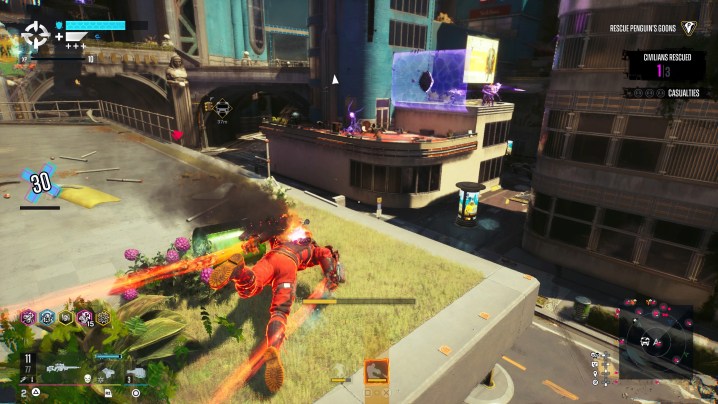
Deadshot uses a jetpack to hover and fly around enemies, while Harley Quinn swings around using an acquired Bat Drone. How your character of choice moves through Metropolis and the gun they fight with are the nuances that will ultimately help determine your favorite. Thankfully, it doesn’t lock character choices in multiplayer depending on who others picked. I enjoyed moving throughout Metropolis like it was a playground, although the fact that you’re often flying or leaping over its rooftops meant I never got that intimately familiar with each nook and cranny of this world despite all the effort that had been put into designing it.
All my friends are heathens, take it slow
Metropolis is simply a foundation for missions and hectic fights to be laid over, and it’s also hard to get immersed in Suicide Squad’s world when it’s constantly throwing me back into menus. Early on in the campaign, there are menus players must sift through after completing every mission in the open world. In multiplayer, this includes an unskippable cutscene highlighting the player with the highest score during that mission and another unskippable animation of a Bat-Pod dropping the loot players earned.
I timed it and found that I was spending upwards of a minute in menus after every single mission in the open world, even the ones that only took three or four minutes to complete. For a game that’s all about getting into the flow of movement during battle and exploration, Suicide Squad sure loves pulling players out of that for a 1-to-4 ratio of unnecessary celebrations and long loot animations. It’s a mission-based multiplayer reward structure that conflicts with open-world design.
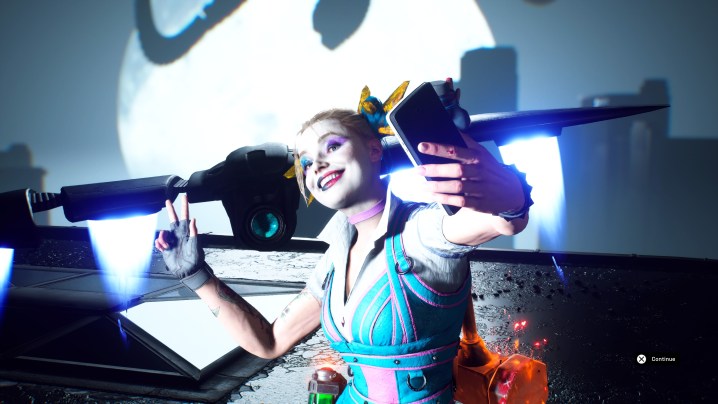
Suicide Squad doesn’t justify the cooperative nature of its setup until well over 10 to 15 hours into the experience. Poison Ivy can modify weapons with afflictions that freeze, burn, poison, or shock enemies, and all players can capitalize on these debuffs. There’s nothing in the way of cooperative takedowns or attack combos, though. Very late in a character’s skill tree, players can earn access to a Squad Ultimate that is shared between the entire team. Most players probably won’t ever see this, though; I didn’t unlock it until after I beat the main story, and dealt with plenty of other frustrations along the way.
Mission failed
Further stoking a general feeling of disappointment is Suicide Squad‘s poor mission design, which relies on played-out genre tropes. You’ll be killing enemies and picking up a collectible they drop, defending points of interest from waves of bad guys, saving captured individuals in between skirmishes with Brianiac’s forces, or escorting and defending a vehicle from point A to point B. While moving around and fighting enemies is entertaining, you won’t do anything you haven’t done in a shooter before.
Loot grinding is the crux of Suicide Squad, but guns don’t stand out.
Missions sometimes come with unique gimmicks — like only letting players damage enemies with critical hits — but those prove more frustrating and fun. While its story is full of surprises, its mission design rarely is. Players of live service games like Suicide Squad inherently have to accept some feelings of repetitiveness because the game encourages them to play every day, spend money on it, and follow seasonal releases. Still, I feel less compelled to stick around when mission design feels this derivative from the start.
That design does allow the occasional inspired moments to stand out even more. Boss fights against The Flash, Green Lantern, Batman, and Superman are game-defining moments because they shake up the core gameplay. Unfortunately, those moments account for less than 10% of the adventure, which ends with a final boss that’s essentially a reskinned version of one from earlier in the campaign.

So, if the missions are uninspired, is it at least a smooth experience to grind missions and rewarding when you get gear from them? Not really. Loot grinding is the crux of Suicide Squad, but guns don’t stand out. Weapons tend to have one to three augments that enhance their abilities but often come with effects that will feel negligible to anyone but hardcore players.
The most satisfying are the Nortorious and Infamy gear sets, which are themed around specific villains like Black Mask, Bane, or Bizzaro. These weapons can activate unique effects on enemies, like Frenzy, and liven up firefights when they’re in play. But once I found these weapons, I was underwhelmed when I’d complete an endgame mission only to be rewarded with a Legendary or Rare gun that wasn’t nearly as exciting. That is part of the random nature of Suicide Squad’s loot drops, and with a limited number of these kinds of weapons available at launch, it’s an issue.
Its greatest injustice
Regardless of whether or not you enjoy Suicide Squad, there’s one undeniable fault with it: its poor user experience. UX is a term thrown around in the tech space that can feel kind of nebulous to a casual player. This game will teach you why it’s so important.
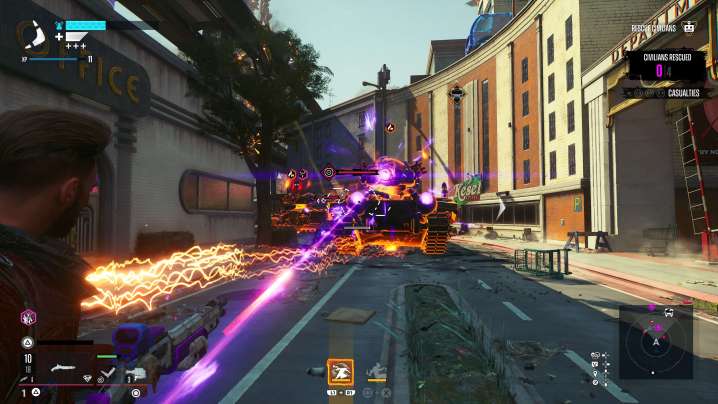
Let’s dissect a screenshot I took of me playing as Captain Boomerang (keep in mind this is before any other visual effect overlays that happen if I lose shield or pass certain combo thresholds). On the top right, the UI tells me about the four civilians I need to rescue in three different ways. On the top left, I get a logo for the character I know I’m playing as and an XP bar I don’t need to see during gameplay. If I had a combo going, that number would also appear on the left side of the screen, and if I was in multiplayer, a score comparison would take up more space on the right.
While the information on the bottom left of the screen showing me the weapons I have is helpful, the mini-map on the bottom right is nearly inscrutable. Meanwhile, my Suicide Strike and Traversal Attack indicators crowd the bottom center. The Squad Ultimate would add a third, bigger icon. Now imagine all the visual indicators that come with enemies, other players, subtitles, and occasional tutorial reminder pop-ups. The screen becomes a crowded mess with lots of information that’s often too small to discern.
I can only pray that a UI overhaul is in the works for this game post-launch.
Because of that, it’s sometimes possible to lose track of where a specific enemy or objective is, even when there’s a button that can be held down to highlight all enemies and that small mini-map. In Suicide Squad’s defense, it does give you the ability to toggle some of these on-screen icons off, but what’s captured above is the default, developer-intended interface, and the UX problems go much deeper than what’s on-screen during a fight.
For instance, the mission flow makes completing open-world missions annoying in multiplayer. I understand getting a reward screen after a 30-minute Incursion, but not after a four-minute rooftop scuffle based on an objective I’ve already done over a dozen times. This is all worsened by the map and mission-tracking menus being a mess. By the endgame, the map is crowded with icons for missions, Incursions, Riddler challenges and trophies, and support squad missions.
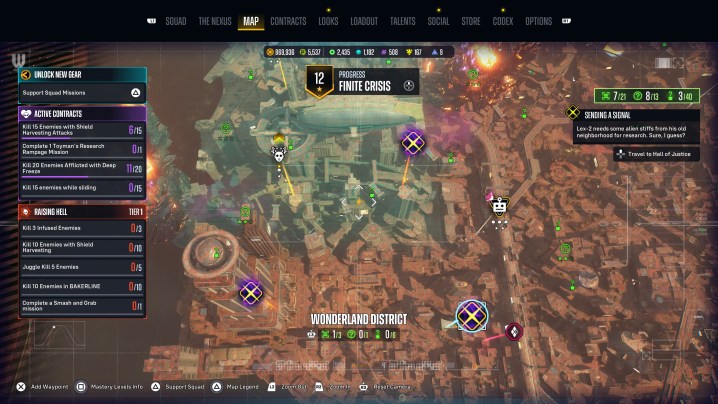
It’s tough to tell which missions you’ve already completed, and reward teasers like “lots of resources” and “awesome gear” are too vague. I have to hold up on the D-pad to check Finite Crisis progress, but this shares an input with the shortcut to fast travel to the Hall of Justice. That will activate if you don’t hold the D-pad direction down long enough. Progression on in-game challenge Contracts are shown on the map screen, but can’t be redeemed there. Instead, you have to go to a separate Contracts menu.
Contracts and missions reward up to seven different types of currency (not including the paid currency) when one or two different types would do. Vendors are mostly useless because you’ll unlock better weapons than you can buy from them; when you do use them, their dialogue subtitles overlap with their menu text. It also tends to overload the screen with so much text and information that you’ll need to spend time studying the meaning of every kind of symbol, currency, and modifiable combat mechanic.
Suicide Squad is not outright broken and buggy like some other multiplayer games were at launch, and it looks quite nice and runs smoothly on my PlayStation 5 hardware. Over 20 hours into the experience, I’m used to its menu eccentricities and familiar with various in-game terms. Still, there’s no denying this is a jumbled visual mess, and I can only pray that a UI overhaul is in the works for this game post-launch.
Dark victory
Suicide Squad has a whole mess of issues that constantly threaten to stamp out any enjoyment players might get during the experience. By the time the tutorials ended, I was already halfway through the campaign. It’s like an MMO in that the “true” experience doesn’t actually start until the endgame. There are skins to buy, but none really have caught my fancy enough to drop $10 on them so far. Microtransactions in a full-priced game are also a bit questionable, as is its always-online nature when it plays just fine with AI bots as teammates in solo play.
There’s a clan system for groups who want to play this game daily for rewards. For that, players need to commit to the Suicide Squad‘s endgame. Rocksteady Studios set up quite a few robust progression systems for grinding, from doing runs for Infamy gear sets to raising Finite Crisis levels to a shared talent tree full of passive buffs that can each be leveled up dozens of times.
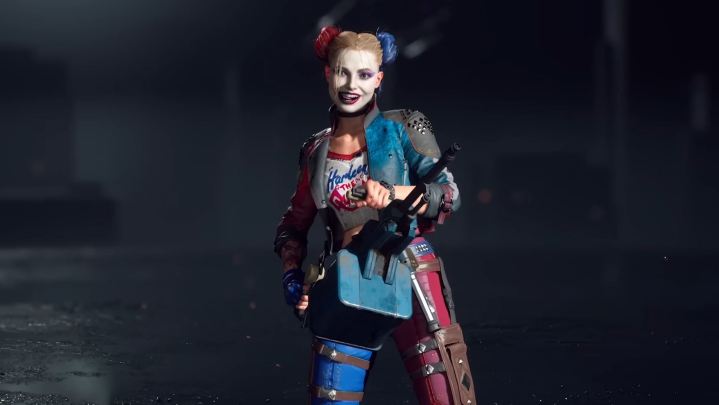
Killing Time, the side mode I enjoy most, also unlocks here. The problem? There’s just not enough content to support this endgame flow yet. Right now, players need to be comfortable grinding four or so different Finite Crisis missions, three of which repeat content and mission types you’ve already done a lot by the time you’ve reached the story’s end. Hopefully, this will improve in the months and post-launch seasons to come, but I can’t bank on it in the world of unpredictable live service support.
Much like the Suicide Squad itself, it feels like there’s a bomb implanted in Kill the Justice League‘s head. It threatens to blow up a solid gameplay system, narrative idea, or other enjoyable aspects of the adventure at every turn. And while that bomb never fully detonates, that lingering threat puts a damper on the entire experience. The Suicide Squad is unable to remove their implants in this game, despite attempting to do so early on. They go on to turn it into an upgradable part of their loadout that improves their abilities. For the sake of Suicide Squad: Kill the Justice League’s future, I hope Rocksteady Studios can do the same.
Digital Trends tested Suicide Squad: Kill the Justice League on the PlayStation 5.
Editors' Recommendations
- Which character should you pick in Suicide Squad: Kill the Justice League?
- Here’s when can you expect our Suicide Squad: Kill the Justice League review
- Every video game delay that happened in 2023
- Divisive Suicide Squad game’s newest look emphasizes story over live service
- Persona 3 Reload will release during a surprisingly packed February 2024



